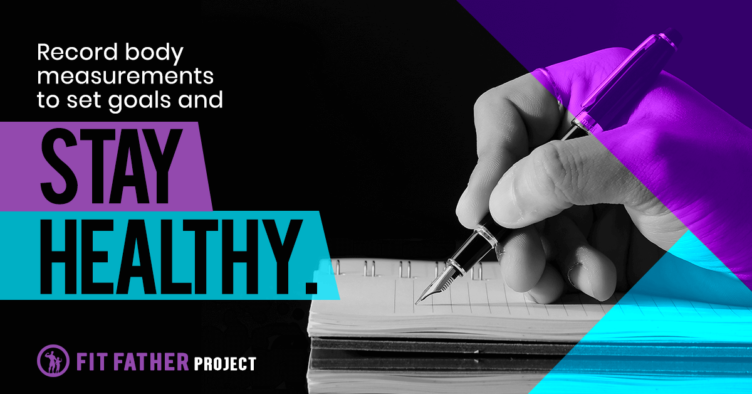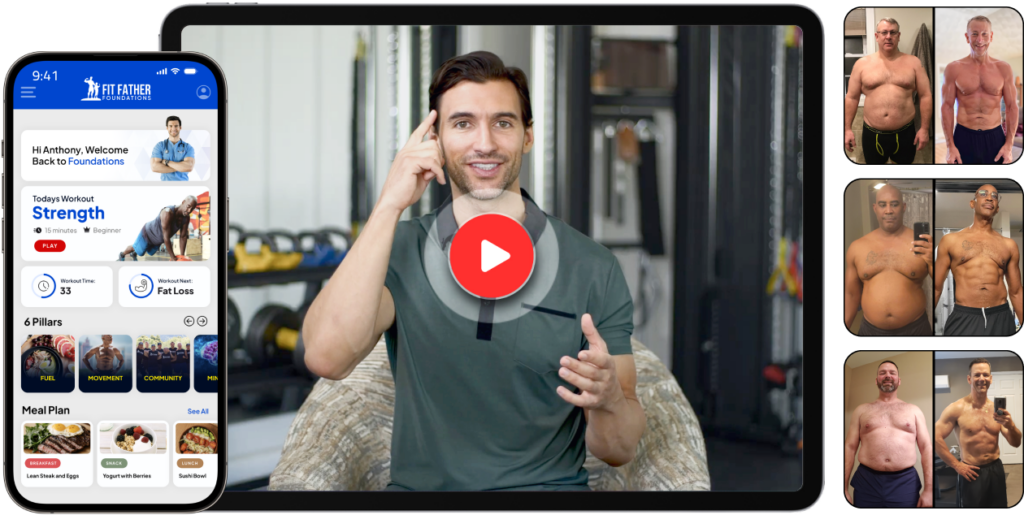It’s beneficial to measure your waist circumference, body weight, resting heart rate, and the other best body measurements for men regularly to determine how healthy you are — and whether or not you’re at risk for chronic disease and early death.
The Best Body Measurements for Men
A few tips and tricks help you utilize the best body measurements for men to achieve or maintain the healthy lifestyle you deserve. Using the following simple body measurements regularly is the key to success.
#1: Waist Circumference
Once of simplest, most research-backed measurements you can take is your waist circumference, or the measurement all the way around your waist.
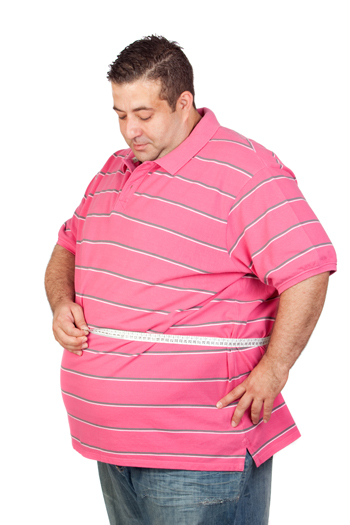 To determine your waist circumference, place a tape measure around your waist at the belly button and record your results.
To determine your waist circumference, place a tape measure around your waist at the belly button and record your results.
This measurement is important, as a large waist circumference (even if your body weight is within a normal range or you work out regularly) is associated with chronic diseases — such as diabetes, high blood pressure, heart disease, and early death.
The type of fat often associated with the abdominal area is called visceral fat, which is the deep fat surrounding your organs. In comparison, subcutaneous fat is the fat right beneath your skin, or the fat you can pinch. Excessive visceral fat seems to be more dangerous than subcutaneous fat.
Studies show that waist circumferences over 35 inches in women and over 40 inches in men increase your chronic disease risk due to excess visceral fat.
#2: Morning (Fasting) Blood Sugar
Blood sugar readings are a good predictor of how well your body manages the sugar in your body, and alert you if you’re on the verge of developing prediabetes or diabetes.
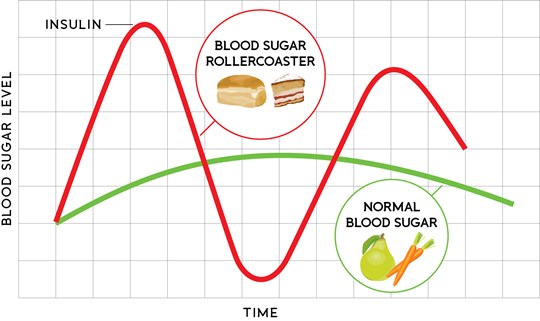 Check your blood sugar when you first wake up before you’ve eaten anything, by pricking your finger with a blood sugar monitoring device. You can pick up this device at your local pharmacy.
Check your blood sugar when you first wake up before you’ve eaten anything, by pricking your finger with a blood sugar monitoring device. You can pick up this device at your local pharmacy.
A blood sugar reading of under 95 mg/dL is a good goal to have. If your fasting blood sugar is consistently over 100 mg/dL, making lifestyle changes is beneficial to help prevent diabetes and other chronic diseases. Changes you can make include:
- Cut out added sugar and refined grains
- Lose weight if you’re overweight
- Boost protein and fiber in your diet
- Begin or continue with a regular workout program
- Boost water intake
A fasting blood sugar of less than 100 mg/dL is normal, fasting blood sugar of 100 to 125 mg/dL is classified as prediabetes, and fasting blood sugar of 126 mg/dL or higher on two separate occasions means you have diabetes.
Fortunately, weight loss and making healthy lifestyle changes helps reverse prediabetes (and possibly diabetes as well).
#3: Morning Heart Rate
Your morning heart rate helps determine how stressed your body is. A high morning heart rate is an indicator of stress in your nervous system or overtraining in athletes. You might also experience high blood pressure if your morning heart rate is high due to stress.
 To determine your morning heart rate, check your pulse with your fingers and record the results, or use an Apple Watch or Smartphone to track it. Use your usual morning heart rate as a baseline. If it’s a little higher than usual, it’s time to:
To determine your morning heart rate, check your pulse with your fingers and record the results, or use an Apple Watch or Smartphone to track it. Use your usual morning heart rate as a baseline. If it’s a little higher than usual, it’s time to:
- Remove yourself from stressful situations
- Drink more water
- Sleep better
- Eat healthier
- Continue a regular exercise program
What’s normal for your individual heart rate may vary, but Mayo Clinic suggests resting heart rates of 60 to 100 beats per minute are considered normal.
Well trained athletes may have resting heart rates near 40 beats per minute. If your heart rate is consistently above 100 or below 60 (or 40 if you’re an athlete), check in with your doctor.
#4: Body Weight Over Time
People who weigh themselves daily often maintain healthy weights better and lose more weight when they’re overweight. Daily morning weigh-ins give you a good idea of whether or not you’re holding water weight, and you can see a slow progression of weight loss or weight gain over time.
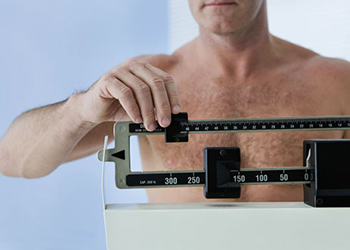 Tracking weight daily makes it easier to meet weight management (weight loss, maintenance, or weight gain) goals.
Tracking weight daily makes it easier to meet weight management (weight loss, maintenance, or weight gain) goals.
If you gain several pounds in one day the weight is likely water weight — and if you’ve lost weight right after working out, you’re likely dehydrated.
Track body weight over time by recording your weight in a paper or online journal (or a health app). Weigh yourself first thing in the morning when you wake up daily to observe a trend over time. Setting measurable, attainable goals helps you avoid falling off the wagon.
If weight loss is your goal, aim to lose about 1 to 2 pounds each week until you reach your goal weight. If you have an unsuccessful week, it’s okay! Start fresh the next week.
#5: Number of Hours Spent Sitting
Sitting is known as the new smoking when it comes to chronic disease risks. Aim to sit less than 6 hours per day, if possible. Sitting more than 6 hours daily increases your risk for chronic diseases and early death — even if you’re a regular exerciser. Track the number of hours you sit each day as a baseline, and aim to decrease this number over time.
 Studies show that long sitting times (more than 6 hours daily) are associated with fatigue, high blood pressure, decreased job satisfaction, and musculoskeletal disorders. Long sitting times also increase your risk for obesity, say researchers who conducted a 2016 study published in Preventing Chronic Disease.
Studies show that long sitting times (more than 6 hours daily) are associated with fatigue, high blood pressure, decreased job satisfaction, and musculoskeletal disorders. Long sitting times also increase your risk for obesity, say researchers who conducted a 2016 study published in Preventing Chronic Disease.
Prolonged sitting without breaks between can be especially detrimental. Ways to sit less and move more include:
- Go for a walk during lunch or coffee breaks
- Walk or bike to work instead of driving
- Use a standing desk at work
- Take a few minutes to walk around every hour you’re sitting down at work
Do what you can to move around every chance you get, burn extra calories, and keep your blood pumping throughout the entire day.
Here’s A Free Weight Loss Meal Plan For Busy Men 40+
Discover exactly what to eat for breakfast, lunch, and dinner to lose belly fat & feel energized 24/7 without hard dieting...
Additional Health Measurements to Track
In addition to the 5 best body measurements for men you should track daily to get or stay healthy, there are several other healthy lifestyle habits you can track in your daily journal, such as:
#1: Hours of Sleep
 When you’re tracking body weight, waist circumference, and the other best body measurements for men, consider tracking hours of sleep each night as well. Getting at least 7 hours of sleep, as recommended by the Centers for Disease Control and Prevention (CDC), each night helps your body function at its best.
When you’re tracking body weight, waist circumference, and the other best body measurements for men, consider tracking hours of sleep each night as well. Getting at least 7 hours of sleep, as recommended by the Centers for Disease Control and Prevention (CDC), each night helps your body function at its best.
Getting plenty of sleep also lowers your risk for obesity, as sleep deprivation is linked with increases in appetite and weight gain over time. Poor sleep also boosts your risk for high blood pressure, heart disease, and diabetes.
#2: Water Intake
 When you’re tracking your morning body weight, be sure you’re properly hydrated to get a true reading.
When you’re tracking your morning body weight, be sure you’re properly hydrated to get a true reading.
This means tracking daily water intake as well, and making sure your urine is light yellow or clear in color (not bright yellow).
Men should aim for at least 16 cups of fluid daily, and women need at least 12 cups per day.
However, you may require additional water if you sweat regularly during workouts.
#3: Grams of Protein and Fiber
Regardless of your body weight goals, tracking protein and fiber grams comes in handy. That’s because protein is a key component of weight loss AND muscle building diet plans. Fiber aids in healthy weight management, helps lower cholesterol, and reduces your chronic disease risks — especially heart disease.
Most Americans consume just half of their recommended daily fiber intake, which is at least 25 to 30 grams daily. Generally speaking, more is better.
Eat fiber rich fruits, vegetables, whole grains, legumes, nuts, and seeds — or take fiber supplements if your doctor recommends it.
Whether you’re seeking weight loss or muscle mass gains, the National Strength and Conditioning Association recommends consuming 1.5 to 2 grams of protein per kilogram of your body weight each day.
This is equivalent to getting 0.7 to 0.9 grams of protein per pound of body weight daily, or 140 to 180 grams daily if you weigh 200 pounds.
Get dietary protein from eggs, lean meats, poultry, tofu, Greek yogurt, cottage cheese, legumes, nuts and seeds, or protein shakes.
#4: Blood Pressure
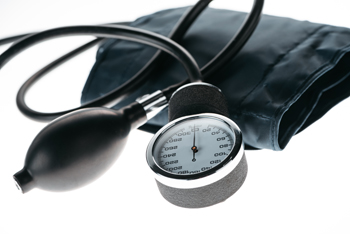 If you have a family history of high blood pressure or take blood pressure medications, measuring blood pressure at home daily or weekly lets you know if your numbers are on track.
If you have a family history of high blood pressure or take blood pressure medications, measuring blood pressure at home daily or weekly lets you know if your numbers are on track.
Simply purchase an at-home blood pressure cuff or other blood pressure monitoring device, and follow the instructions.
A healthy blood pressure goal is 120/80 mmHg or below.
#5: Body Mass Index (BMI)
Your body mass isn’t (BMI) isn’t necessarily the best indicator of body fatness, because it’s based on weight and height and muscle weighs more than fat. But unless you’re extremely muscular, your BMI is a good indicator of how healthy you are.
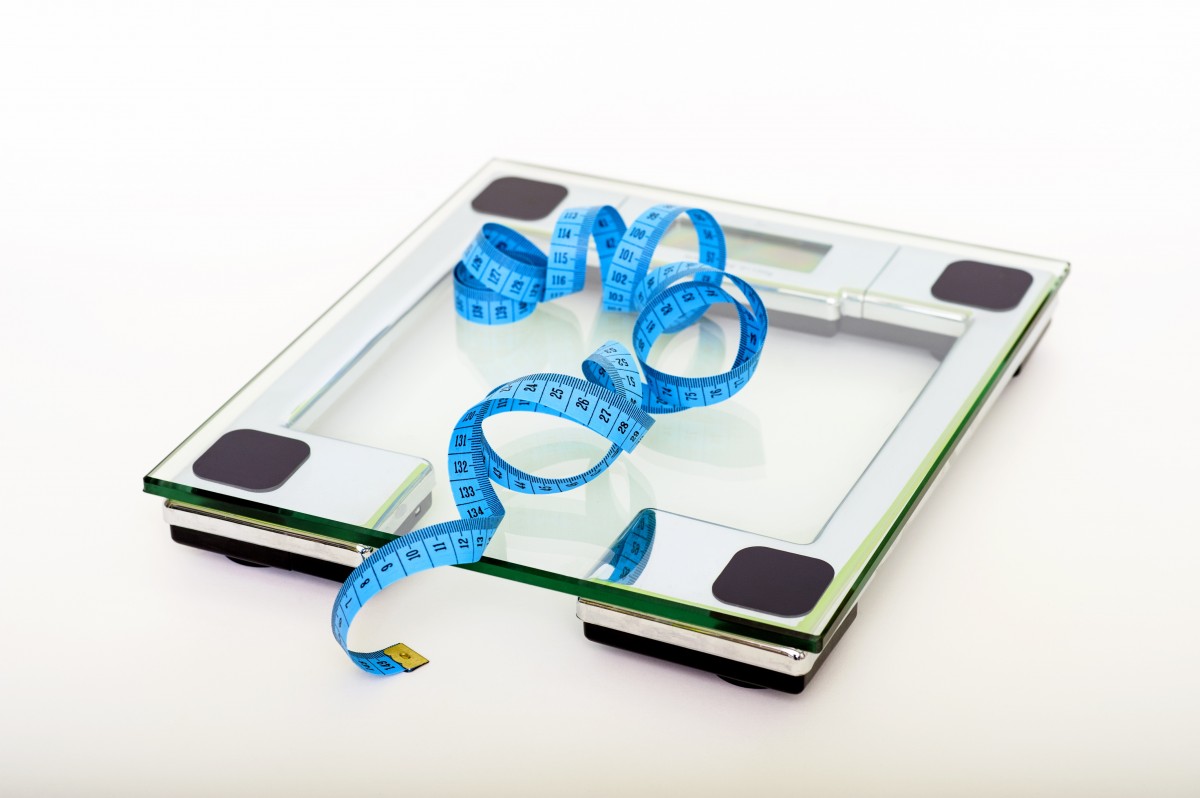 Aim to achieve a BMI of 18.5 to 24.9, which is within the normal range.
Aim to achieve a BMI of 18.5 to 24.9, which is within the normal range.
Use an online BMI calculator to determine your body mas index. You can also multiply your body weight in pounds by 703, divide by your height in inches, and divide by your height in inches again to calculate your BMI.
If you’re very muscular, use another method for measuring body fat — such as waist circumference measurements, skin fold calipers, or a bioelectrical impedance (BIA) machine.
#6: Hours of Exercise
Tracking hours of exercise is another great way to determine how healthy you are, and keep chronic disease risks low. When you track the 5 best body measurements for men, record how many hours each week you’ve exercised.
The Physical Activity Guidelines for Americans 2020 recommend getting in at least 150 to 300 minutes of moderate-intensity exercise weekly, plus resistance training at least two days each week.
#7: Calorie Intake
If you're overweight or want to gain lean muscle, track your calories (using an online calorie counting tool or app) to boost your chance at meeting body weight goals. Men seeking weight loss often require 1,500 to 1,800 calories a day. If muscle building is your goal, increase your current energy intake by 350 to 700 calories a day.
#8: Lab Values
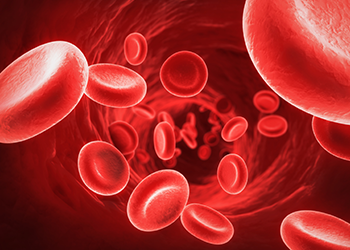 Seeing your doctor regularly means he or she can order blood tests to check additional health measurements, such as:
Seeing your doctor regularly means he or she can order blood tests to check additional health measurements, such as:
- HDL, LDL, and total cholesterol
- Triglycerides
- Vitamin and mineral status
- Hormone levels (testosterone, thyroid hormone, etc.)
Your doctor lets you know if your cholesterol or triglyceride levels are high (which increases heart disease risks), if you’re deficient in vitamins or minerals, and if hormone levels are within a healthy range. Knowing all of these values helps you improve your health and set attainable goals.
The Benefits of Body Measurements for Men
What gets tracked gets improved. Tracking the best body measurements for men and lifestyle habits is one of the best ways to improve in areas you're struggling. If you have a starting point, good or bad, you can track progress over time and set attainable, measurable goals.
Numerous studies show the benefits of tracking healthy lifestyle habits. For example, a 2011 study published in The Journal of the American Dietetic Association found that using self-monitoring tools, such as food diaries, exercise log-ins, and weigh-ins, is associated with greater weight loss in overweight adults.
Here’s A Free Weight Loss Meal Plan For Busy Men 40+
Discover exactly what to eat for breakfast, lunch, and dinner to lose belly fat & feel energized 24/7 without hard dieting...
Move Toward a Healthier Lifestyle
Tracking the best body measurements for men is a starting point to help you reach healthy lifestyle and weight management goals. To get started with weight loss or long term healthy weight management, try Fit Father Project’s FF30X weight loss program designed for busy men over 40.
FF30X provides you with motivational support, advice from health and fitness experts, a free 1-day meal plan, and a free metabolism-boosting workout to steer you in the right direction with your weight management journey.
If weight gain is your goal, boost protein and overall energy intake (by 350 to 700 calories a day) — and try Fit Father Project’s Old School Muscle program to pack on lean body mass.
Lifestyle changes take time, and using the best body measurements for men is just one tool that boosts your chance at success. Take it one step at a time, you can do it!
Erin Coleman, B.S. Nutritional Science, R.D., L.D.
Writer, Fit Father Project
Erin Coleman is a registered and licensed dietitian with over 15 years of freelance writing experience.
She graduated with her Bachelor of Science degree in nutritional science from the University of Wisconsin-Madison, and completed her dietetic internship at Viterbo University in La Crosse, Wisconsin.
Prior to beginning her career in medical content writing, Erin worked as Health Educator for the University of Wisconsin-Madison Department of Internal Medicine.
Her published work appears on hundreds of health and fitness websites, and she’s currently working on publishing her first book! Erin is a wife, and a Mom to two beautiful children.
Join our 6-Week Doctor Designed Health Program. You'll Gain Foundational Health for the Rest of Life.
The FOUNDATIONS Program is created by Dr. Anthony Balduzzi for Men 40+ who want Lifelong Health.
In just 6-Weeks following FOUNDATIONS, you'll experience:
- Rapid decrease in body fat
- Dramatically improved energy levels
- Greater mental sharpness & clarity
- Muscle gains & better cardiovascular fitness
- Decreased inflammation & pain
- Renewed motivation & greater focus on health.
FOUNDATIONS has transformed 60,000 lives! Are you ready to experience true lasting health & results?
- We'll help you drop unhealthy habits forever
- We'll show you the EASIEST way to eat healthy for life.
- You get Doctor-Designed Workouts for Men 40+
- You gain Daily Accountability & support from our team of doctors & certified personal trainers.

